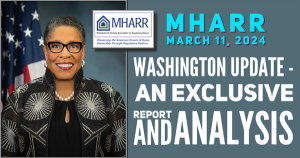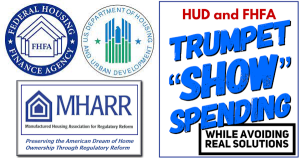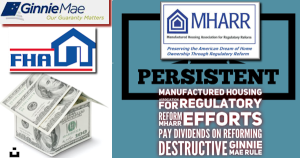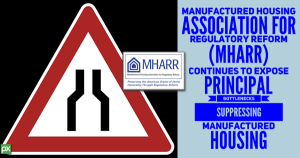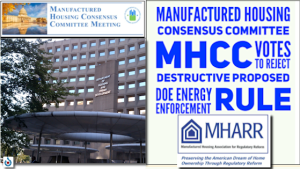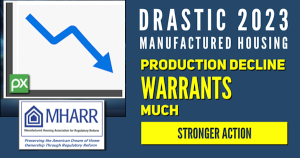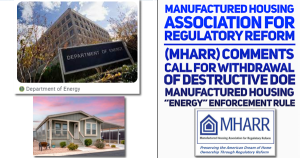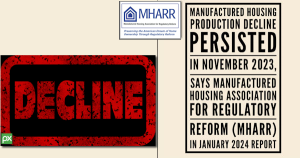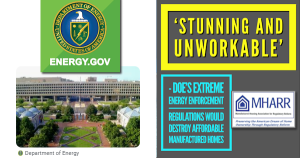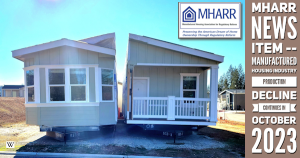[vc_row][vc_column][vc_column_text]As MHARR continues to expose the outlines, extent and sheer audacity of HUD’s ongoing power grab under Administrator Pamela Danner to dictate installation standards and enforcement procedures in all fifty states – including states with complying, HUD-approved, state law installation programs – the Association has received a wave of concerned inquiries from industry members and other direct stakeholders asking for more information on how and why this has come about, and what can be done to halt this effort to emasculate the federal-state partnership underlying the HUD manufactured housing program, as well as the primacy of state installation regulation as designed and mandated by the Manufactured Housing Improvement Act of 2000.
In order to fully comprehend the significance of this installation power grab — orchestrated by HUD regulators and revenue-driven program contractors — two points must be understood. The first, is that regulators, by nature, regulate. It is up to the “regulated,” therefore, to ensure that such regulation is in compliance with applicable law. Unfortunately, though, with half of the industry accustomed to going-along-to-get-along, such is not the case with manufactured housing. Indeed, there is no limit on the mandates that federal regulators (and their unaccountable contractors) will seek and demand, unless and until the industry pushes-back. This has been the case with production regulation and the role of MHARR, which was formed 30-plus years ago, with the specific mission of fighting against unfair, excessive and unreasonable regulation. Unfortunately, the post-production sector has no comparable organization or institutional force to resist HUD, leaving a vacuum that the Department and its contractors are now only too happy to fill.
Second, and given point one above, MHARR knows – and has tried to educate program stakeholders (and particularly the industry’s post-production sector) – that it is the ultimate goal, desire and objective of the federal program and its revenue-driven contractors to federalize and control installation. Thus: (1) with revenue-driven program contractors constantly seeking to expand “make-work” opportunities and revenue sources; (2) with HUD Code manufacturers building their best homes ever, as far as the in-plant production process is concerned; and (3) with a pro-regulation, contractor-friendly program administrator in place at HUD, the “new frontier” for HUD regulatory expansion has shifted to the post-production arena, and specifically to opportunities within the realm of installation regulation.
Beyond these observations — and for those who may still not grasp the full and profound significance of this effort to completely federalize installation regulation — two additional points stand out. The first is that a de facto federal takeover of installation regulation, in violation of the 2000 reform law, will hurt all segments and sectors of the industry (as well as consumers and states with approved installation programs), but retailers and especially communities will suffer the most direct impacts and the most costly harm. The second is that such abusive behavior can only be stopped if all program stakeholders – and particularly industry members — mobilize and take action (for the ultimate benefit of consumers) to halt and reverse an utterly baseless assault on the states and the very foundations of the HUD program as a federal-state partnership.
While this issue of installation regulation can seem complex – and is widely misunderstood both within and outside of industry circles — it actually is not (particularly for those who participated directly in the development and enactment of the 2000 reform law). The evolution of the installation regulation provision now contained in the 2000 reform law, as explained in the March 2016 edition of the MHARR Viewpoint – entitled “As Predicted by MHARR, HUD Delivers Worst of Both Worlds on Installation” (published in The Journal of Manufactured Housing), bears reiteration:
“Once again, predictions made years ago by MHARR regarding HUD’s failure to correctly interpret and implement the Manufactured Housing Improvement Act of 2000 – and the profoundly negative consequences of those failures — are being proven true and accurate. *** The latest example of MHARR early-warnings going unheeded, but now being validated, concerns installation regulation and the HUD program’s mangled, distorted approach to the installation mandates of the 2000 reform law, which will inevitably harm both the industry and consumers, saddling both with excessive and unnecessary regulatory compliance costs.
Coupled with dispute resolution, the installation provisions of the 2000 reform law were adopted to close significant gaps in the original National Manufactured Housing Construction and Safety Standards Act of 1974, as construed by HUD. Although the industry – and manufacturers in particular – have always supported sound consumer protection and the safe and proper installation of manufactured homes (which had been at the root of the overwhelming majority of consumer complaints prior to the 2000 law), HUD determined, early-on that it would not address the installation of manufactured homes under the 1974 law, because that law did not include specific authorization for such standards.
Recognizing, however, that proper installation is crucial: (1) to the proper performance of a manufactured home; (2) to the value of that home to its owner and consumer finance providers; and (3) to public and government acceptance of manufactured homes as legitimate “housing,” rather than “trailers,” the industry and consumers went back to work for nearly 12 years, together with other stakeholders, to develop the installation provisions that were ultimately included in the 2000 reform law.
The result was a statutory structure, based on the 1994 recommendations of the National Commission on Manufactured Housing, which authorized any state that wished to do so (i.e., a “complying” state), to establish (or continue) a state-law installation program and state-law installation standards, so long as those requirements provided protection that met or exceeded baseline federal standards to be developed by the Manufactured Housing Consensus Committee (MHCC) and adopted by HUD. HUD, by contrast, was authorized to regulate installation in non-complying (i.e., “default”) states that failed to adopt a state-law installation program within five years of enactment of the 2000 law.
This structure … advanced by MHARR … was consistent with the nearly-universal view of program stakeholders that varying soils and other installation-related conditions in different geographical areas made states the best and most appropriate party to regulate the siting of manufactured homes. The 2000 reform law, consequently, allows states to take the lead role in the regulation of installation, with HUD assuming that duty only in default states that fail to adopt and implement a conforming state-law program.
What the 2000 reform law specifically does not do, however — again recognizing, as it does, the unique competence and ability of the states and state authorities to determine proper installation systems and techniques within their own borders – is authorize or direct HUD to substitute its judgment for that of state authorities regarding the specific details and elements of any given state installation standard. Put differently, the 2000 law allows HUD to determine whether a state-law installation program and state-law installation standards as an integrated “whole” provide consumers with a level of protection equal-to-or-greater-than the HUD standards, but does not provide back-door authority for HUD to micro-manage state-law programs and/or standards or over-ride state judgments regarding the need for — or content of — any specific installation requirement.
Refusing to accept this fundamental aspect of the 2000 reform law, however, HUD, from the start, sought to undermine the law’s clear division of federal-state responsibility and its preference for state regulation of installation (including an express reservation of state installation authority added to the preemption section of the law), by separating installation from the Part 3280 Federal Manufactured Housing Construction and Safety Standards, thus giving rise to the “re-codification” of installation. While MHARR vigorously opposed this re-codification and the MHCC rejected it as well, HUD ultimately got its way through the tacit acceptance of [others within the industry].
As early as 2004, therefore, then-MHARR President and CEO Danny Ghorbani warned that HUD appeared intent on controlling installation and dictating installation criteria everywhere, including complying states with approved state-law programs. In an MHARR Viewpoint article entitled “Federal Installation Trap?” he wrote: “[F]rom both its approach to the substance of the model federal standard, and from the information that MHARR has been able to obtain, it appears that HUD has not abandoned its ambition to totally federalize installation regulation, under its control.”
Now, more than a decade later … this prediction is coming true, as HUD (both directly and via a non-accountable installation contractor) seeks to use the State Plan approval and re-certification process to over-ride and replace – or compel state officials to revise, modify and replace – state-adopted installation standards in complying states. This HUD activity … has the potential [of] … dire consequences for consumers and the industry, but also for the co-equal federal-state partnership that Congress envisioned for the HUD program.
(Emphasis added).
Indeed, MHARR’s warnings regarding the potential federalization of installation regulation in all 50 states by a Department intent on resisting and circumventing the reforms of the 2000 law were detailed even further in a visionary December 2004 MHARR Viewpoint article (again, authored by Danny Ghorbani) entitled, “Federal Installation Trap – Initial Findings:”
“As has been noted on many prior occasions, the Manufactured Housing Improvement Act of 2000 was designed to give the individual states the ‘first option’ to regulate the installation of manufactured homes. Congress structured the Act this way based on the common sense notion that local soil, weather and siting conditions will inevitably vary, and that state governments are in a better position to evaluate and respond to such conditions as contrasted with federal authorities. More importantly, though, Congress also chose this structure – placing the federal authorities in charge of production and state authorities in charge of [post-production] issues – in order to promote and strengthen the federal-state partnership that was established by the original 1974 manufactured housing Act. *** As a result, the 2000 Act gave the states up to five years … to adopt installation standards and programs under state law. If, and only if, a state did not adopt a program by that deadline, did Congress empower HUD to impose a default federal installation standard and federal installation program developed through the statutory consensus process.
While Congress wanted the states to be pre-eminent in the area of installation regulation, this has not stopped HUD from taking various steps that could be interpreted as moving toward a much broader federal involvement in installation or even, in a worse-case scenario, the substitution of federal regulation for state-based regulation. These steps, moreover, must be viewed in the context of HUD’s historical approach to the manufactured housing program…. Given this history … there is valid reason to be skeptical of the program’s actions regarding these regulations.
***
[One such] concern is the program’s approach to the MHCC-developed model installation standard. Under the 2000 Act, the consensus federal standard is designed to be enforced in states that do not adopt state-law installation standards and enforcement programs. It is, by its nature, designed to be a minimum default standard and program for adoption in states that do not have a qualifying standard and program by the deadline established by the Act. This is why MHARR and others are concerned that the present proposed [HUD] rule is titled the “Model Manufactured Housing Installation Standard” rather than the “Model Manufactured Housing Installation Standard to be Enforced in Default States.” While the difference in terminology might seem academic, it is essential that HUD be compelled to recognize the default nature of the federal rule. *** Otherwise, the [federal] program could attempt to impose the federal standard and program on all states. This, in turn, could result in the imposition of prescriptive federal criteria on installation, in a ‘one-size-fits-all’ approach that could also include … Subpart I-type monitoring and enforcement for ‘non-conformances.’ It is thus essential that the industry work to ensure that state-preeminence and state discretion in [installation] regulation are preserved and maintained.”
(Emphasis added).
This prophetic warning and its call for concerted and aggressive industry action is even more consequential now that HUD is actually taking concrete steps designed to achieve a de facto 50-state takeover of installation regulation. With the proverbial “chickens coming home to roost,” and MHARR’s long-ago concerns and predictions being validated, the question becomes, “what can the industry and other program stakeholders do to halt this effort and restore the federal-state power balance regarding installation that was intended by Congress under the 2000 reform law?”
The first step – as always — will be to admit that there is a serious problem emerging regarding installation, and that HUD’s attempted takeover of installation is not routine, “business as usual,” where part of the industry can go along to get along, as is so often the case. Indeed, given MHARR’s early and repeated warnings on this topic, the apparent lack of concern and engagement on this issue by industry members (particularly retailers and communities), some industry state associations and others – over the course of years – and even more so now, is startling. This absence of aggressive engagement also helps to explain, at least in part, a distressing lack of understanding and information – at the industry grassroots level – about just what HUD is up to, and how it could severely impact the industry’s post-production sector.
It is thus incumbent upon – and should be a priority for – all industry members, including state associations, as well as consumers, state governments and other manufactured housing program stakeholders, to fight-back against HUD’s installation power-grab (including engagement with members of Congress), to halt and reverse HUD’s effort to usurp the proper and legitimate role of the states, and to ensure that the crucial role of installation regulation and enforcement is preserved for responsive and accountable state government agencies, rather than being transferred to unaccountable, revenue-driven contractors.
Mark Weiss
MHARR is a Washington, D.C.-based national trade association representing the views and interests of independent producers of federally-regulated manufactured housing.
“MHARR-Issues and Perspectives” is available for re-publication in full (i.e., without alteration or substantive modification) without further permission and with proper attribution to MHARR.
[/vc_column_text][/vc_column][/vc_row]



